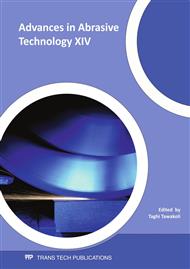p.3
p.12
p.19
p.28
p.35
p.42
p.48
p.54
Research on Workpiece Surface Temperature and Surface Quality in High-Speed Cylindrical Grinding and its Inspiration
Abstract:
The temperature in cylindrical grinding contact zone is difficult for measurement. Relative to the fixed workpiece in surface grinding, the workpiece rotation in cylindrical grinding brings challenges to the temperature measurement. In grinding titanium alloy, more heat will be generated, and due to the poor thermal conductivity of this material, it is easy to make the high temperature rise in the grinding zone. The high surface temperature and its distribution along the depth of the workpiece have great impacts on the grinding burn, metamorphic layer and residual stress. In order to improve the surface quality of machined parts, based on the undeformed chip thickness, this paper proposed a quadratic curve heat flux distribution model to predict the surface temperature distribution in the grinding of titanium alloy (TC4). Experimental results showed that the quadratic curve model under the condition of the measured grinding power, can predict the temperature distribution in the cylindrical grinding zone. Meanwhile, it specifically discussed the impact of the wheel speed on the TC4 surface roughness and the stress distribution, and found the "high-speed" definition in high-speed grinding should be distinguished from the traditional way only judged by the wheel speed, different workpiece materials should be with different "speed" ranges for acquisition of better machining quality.
Info:
Periodical:
Pages:
19-27
Citation:
Online since:
August 2011
Authors:
Price:
Сopyright:
© 2011 Trans Tech Publications Ltd. All Rights Reserved
Share:
Citation:


